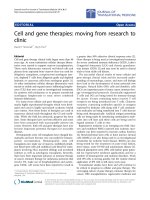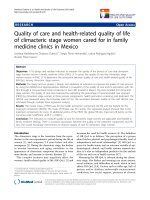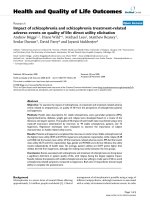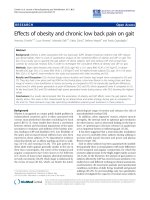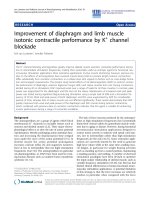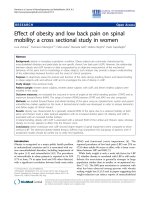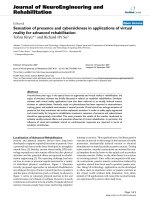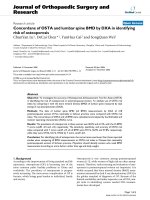Báo cáo hóa học: " Kinetics of Si and Ge nanowires growth through electron beam evaporation" ppt
Bạn đang xem bản rút gọn của tài liệu. Xem và tải ngay bản đầy đủ của tài liệu tại đây (1.06 MB, 8 trang )
NANO EXPRESS Open Access
Kinetics of Si and Ge nanowires growth through
electron beam evaporation
Pietro Artoni
1,2
, Emanuele Francesco Pecora
1,2,3
, Alessia Irrera
1*
, Francesco Priolo
1,2
Abstract
Si and Ge have the same crystalline structure, and although Si-Au and Ge-Au binary alloys are thermodynamically
similar (same phase diagram, with the eutectic temperature of about 360°C), in this study, it is proved that Si and
Ge nanowires (NWs) growth by electron beam evaporation occurs in very differ ent temperature ranges and fluence
regimes. In particular, it is demonstrated that Ge growth occurs just above the eutectic temperature, while Si NWs
growth occurs at temperature higher than the eutectic temper ature, at about 450°C. Moreover, Si NWs growth
requires a higher evaporated fluence before the NWs become to be visible. These differences arise in the different
kinetics behaviors of these systems. The authors investigate the microscopic growth mechanisms elucidating the
contribution of the adatoms diffusion as a function of the evaporated atoms direct impingement, demonstrating
that adatoms play a key role in physical vapor deposition (PVD) NWs growth. The concept of incubation fluence,
which is necessary for an interpretation of NWs growth in PVD growth conditions, is highlighted.
Introduction
The synthesis and the ta iloring of the electrical and
optical properties of nanostructured materials are fasci-
nating research fields, and they represent a suitable
route in a wide range of potential nanoscale device
applications. Among these, axial structures such as C
nanotubes and group IV semiconductor nanowires
(NWs) are a realistic addition because of the quantum
confinement of their carriers in the planar direction and
because of their high surface/volume ratio. In the litera-
ture many simple device structures have been demon-
strated taking advantage of the enhanced electrical
properties of the NWs [1-3], of their quantum confine-
ment for light emission [4,5] or detection [6], of the
decoupling of the light absorption and carrier extraction
for efficient solar cell elements and of the enhanced sur-
face effects as biochemical sensors [7,9], o r of their
structure for high-performance anode batteries [10 ]. A
broad selection of NW composi tion and band structures
is reported, but group IV semiconductor NWs are the
most interesting at the moment because they can be
easily integrated wit h the curr ent CMOS technology. In
particular, Si is the leading semiconductor, and its
unlimited abundance makes it as the primary element
for the future applications. On the other hand, Ge is
experiencing a renewed interest, and it has been recently
proposed for specific high-frequency applications [11].
Si and Ge NWs can be synthesized following a bot-
tom-up approach, named vapor-liquid-solid (VLS) [12].
By exploiting the self-assembling capability of the semi-
conductor atoms coming from the vapor phase to dif-
fuse toward metallic droplets to form a eutectic liquid
phase and, at the same time, to supersaturate the dro-
plets performing the NWs axial growth, this approach
allows the control of all the structural features of the
NWs such as length, radius, and cryst allogr aphic prop-
erties. Gold has been usually chosen as a catalyst, and
the influence of its diffusion on the NW sidewall has
been extensively investigated [13]. Different techniques
usually benefit of the VLS mechanism. Chemical vapor
deposition (CVD) h as been widely used to grow NWs
through the VLS mechanism. The peculiar issue of this
technique is the active chemical role of the metal dro-
plet, which catalyzes the cracking of the precursor mole-
cule in such a way that elemental atoms are formed
under the gold droplet, and the interaction with the
overall substrate is quite absent.
On the contrary, the physical vapor deposition (PVD)
techniques i nvolve a different feeding contribution other
than direct impingement. In fact, the metal droplet repre-
sents a thermodynamic constraint only. It determines the
* Correspondence:
1
MATIS IMM-CNR, Via Santa Sofia 64, I-95123 Catania, Italy
Full list of author information is available at the end of the article
Artoni et al. Nanoscale Research Letters 2011, 6:162
/>© 2011 Artoni et al; licensee Springer. This is an Open Access article distributed under the terms of the Creative Commons Attribution
License ( w hich permits unrestricted use, distribution, and reproduction in any medium,
provided the original work is properly cited.
area in which the eutectic conditions are reached. On the
other hand, the evaporated Si or Ge atoms reaching the
substrate interact with the surface atoms, bond with them,
and start to diffuse. They actually act as adatoms, and it is
demonstrated that they play a fundamental role in the
NWs growth. In particular, the microscopic growth
mechanisms governing the Si and Ge NW s growth in elec-
tron beam evaporation (EBE) technique are investigated in
detail. E BE is a PVD technique a nd, in contras t to the
MBE, it is a non-ultra-high vacuum, very flexible, and eco-
nomic p reparation technique with broad indust rial applica-
tions due to its very high potential deposition rate. In the
very recent times, it has been successfully proposed for the
growth of group IV semiconductor NWs because, despite
its non-UHV regime, NWs synthesized by EBE have high
crystallographic quality (they are single crystal and possibly
faceted), and it is possible to control their length, density,
as well as their crystallographic growth direction by chan-
ging the experimental parameters [14,15].
Si and Ge have the same crystallographic structure,
with a lattice misfit of about 4% only. Moreover, the Si/
Au and Ge/Au phase diagrams a re very similar too:
each one has a single eutectic point, placed at substan-
tially the same temperature (about 360°C), and the semi-
conductor percentages in the alloy at the e utectic
temperature are comparable (19 and 28%, respectively)
[16]. From a thermodynamic p oint of view, their beha-
vior with respect to the NW growth by VLS can be con-
sidered the same. Nevertheless, in this article, it is
demonstrated that Si and Ge NWsgrowth occur in very
different temperatures and fluence regimes. The growth
mechanisms elucidating the relevance of the kinetic
behavior of Si and Ge adatoms on the axial growth rate
are investigated in detai l. Finally, the co ntribution of the
direct impingement vs the surface diffusing ad-atoms to
the NWs growth in a PVD system is clarified.
Experimental
Samples have been prepared in an EBE chamber which
allows multiple subsequent evaporations from dissimilar
and separate crucibles. Au pellets, Si ingots, or Ge
ingots have been used as the sources. The evaporation
flux and the nomi nal planar film thickness were mea-
sured in situ through a quartz microbalance. The den-
sity of these layers has been measured by comparing the
thickness (measured using sca nning electron micro-
scope–SEM) with the atomic areal density (measured
using Rutherford backscattering spectrometry). In con-
trast to Si layer, Ge layer grown by EBE shows a deeply
terraced surface. Moreover, some voids are visible
between terraces, and the effective density of this Ge
layer is about a 20% lower than the Ge bulk density.
Therefore, the evaporated flux impinging on each sam-
plewassettothevalueof2.5×10
14
cm
-2
s
-1
in the
case of Si and to the value of 1. 5 × 10
14
cm
-2
s
-1
in the
case of Ge, to obtain the same velocity of growth of the
planar films, set at a constant value of 0.05 nm s
-1
.The
evaporated fluence has been varied in the range from
0.25 to 2.50 × 10
18
atoms c m
-2
. The apparatus is
equipped with a substrate holder which can be heated
through Joule effect up to 800°C.
(111)-oriented n-type Si pieces are used as substrates
in all the cases. Sample preparation procedure compre-
hends surface cleaning (UV oxidation followed by a dip
in HF etching) to remove all surface impurities and to
avoid any oxygen contamination. In fact, it has bee n
demonstrated that the presence of the native Si oxide
inhibits the NWs growth [17,18]. Then, the samples are
loaded in the vacuum chamber (base pressure of 1-2 ×
10
-8
mbar) where a 2-nm-thick Au layer has been first
evaporated on top of the sample keeping it at room
temperature. After deposition, a thermal annealing at
700°C for 2 h has been conducted to break the cont inu-
ous layer and induce the formation of gold droplets on
the substrate. These steps are repeated for all the sam-
ples in such a way that the substrate, the catalyst size
distribution, and density are always the same. Then, Si
or Ge is evaporated at the desired growth temperature,
performing the NWs growth.
Structural characterization is performed using a FE-
SEM Zeiss Supra 25. Plan, 65° tilted, and cross images
are performed to investigate surface properties, NWs
structural features, and layer thicknesses. Statistical ana-
lyses are conducted using the Gatan Digital Microscope
software. Focused ion beam (FIB) experiments are per-
formed with a 30-keV Ga
+
FIB FEI V600.
Results and discussion
Growth mechanisms
Figure 1 shows the low-magnification SEM images of
typical samples of Si (a) and Ge (b) NWs. In particular,
these were prepared after evap oration of a Si fluence of
1.75 × 10
18
atoms cm
-2
(Figure1a)oraGefluenceof
1.00 × 10
18
atoms cm
-2
(Figure 1b). The bottom insets
of Figure 1a, b show high-magnification images of Si
and Ge NWs samples, respectively. The growth tem-
perature was set at 480°C in both cases. Both Si and Ge
NWs are clearly visible with the Au droplet standing on
top of them. The growth direction of these NWs is
(111) (they are perpendicular to the substrate), since
these growth parameters lead to a major percentage of
(111) NWs, while other crystallographic directions are
observed at different growth temperatures or evaporated
fluences, as has already been demonstrated earlier
[14,15].AkeyissueoftheNWsgrowthbyEBEisthe
competition between the axial growth and the planar
growth of a layer all over the sample. In fact, the evapo-
rated atoms reaching the heated substrate from the
Artoni et al. Nanoscale Research Letters 2011, 6:162
/>Page 2 of 8
vapor phase can directly impinge on the gold droplet or
interact with the overall substrate, becoming adatoms.
Depending on the substrat e temperatu re, they can dif-
fuse on the surface of the sample, and if they are not so
far from the Au droplet, then they can diffuse along the
NW sidewall eventually reaching the metal/semiconduc-
tor interface contributing effectively to the axial growth.
On the other hand, the adatoms stop when they form
more than one stable bonding with the surface atoms,
contributing to the growth of a planar layer. A film is
clearly visible both in Si and Ge NWs samples growing
on top of the substrate. A cross-sectional SEM images
of Si and Ge NWs samples are shown in the top inset
of Figure 1a, b, respectively: the Si and Ge layer on top
of the Si substrate is visible, and the Si and Ge NWs
overcome this layer. Such a competition between the
planar versus the axial growth has been modeled by
Dubrovskii et al. [19] and it has been observed in the
NWs growth both by MBE [20,21] and EBE [14,22,23].
In particular, the presence of a dip around the NWs
clearly demonstrates that the atoms missing from the
planar layer act as a sort of reservoir contributing to the
axial growth of the NWs. The surface area of this dip is
named as the “collecting area.” Only atoms impinging
inside this ar ea can potentially contribute to the NWs
axial growth. For an effective contribution, these ada-
toms should not be desorbed from the substrate, or be
adsorbed (in this way, they would contribute to the pla-
nar layer growth), and finally they have to be able to
reach the growing NW up to the metal/semiconductor
interface. The relevant role played by kinetic processes
for the NWs growth in PVD techniques is evident as
well as the thermodynamic constraints. It has been
recently demonstrated for Si grown by EBE, by inv esti-
gating the role of oxygen contaminations in relation to
the adatoms surface diffusivity [18].
In the later sections of this article, the authors will
elucidate the adatoms contribution by comparing the Si
and Ge growth regimes. In fact, these two semiconduc-
tors have strong differences from a kinetic point of
view. Despite the presence of adatoms diffusion on the
substrate proceeds with the same mechanism (one of
the four dangling bonds links with a dangling bond of
the surface and diffusion continues till the adatom finds
amorestablepositionwhereitcansaturatetwoor
more dangling bonds), and it is well known that Ge sur-
face diffusivity on Si is very differe nt from the self-diffu-
sion of Si [24]. Moreover, the melting point of Ge is
475°C lower than that of Si, and solid-phase epitaxy
regrowth in Ge has a lower activatio n energy (E
Ge
=2.0
eV)thaninSi(E
Si
= 2.7 eV), with the same pre-expo-
nential value (about of 3 × 10
8
cm s
-1
). As a conse-
quence, recrystallization processe s in Ge occur at much
lower temperatures with respect to the typical Si tem-
perature processes for cr ystalline growth [25,26]. The
differential bond energy between Si/Si and G e/Si atoms
can account for this difference, and, consequently, for
the very different mobilities of these species. Moreover,
according to Zakharov et al. [27] referring to t he MBE
growth technique, atoms directly impinging on the cat a-
lyst droplet allow the growth of the NWs in maintaining
the Au droplet on top of it with a maximum axial rate
that is equal to the planar rate. One could expect that Si
orGeNWsgrowthisobservableinthesameregime
with similar structural features. On the contrary, it is
shown that these two nanostructures grow at different
temperatures and different fluence regimes, and these
results are correl ated to the different Si and Ge adatoms
kinetics on the substrate.
Temperature dependence
Figur e 2 reports the Si (red dots) and Ge (blue squares)
NWs lengths as a function of the growth temperature
for an evaporated fluence of 1.75 × 10
18
cm
-2
.The
Figure 1 SEM images of Si NWs and Ge NWs. (a) Low-
magnification SEM images of sample of Si NWs. The bottom inset
shows a higher magnification of a Si NW. The top inset is a cross-
sectional SEM image of the sample showing the substrate and the
2D Si layer on top of it. (b) Low-magnification SEM images of Ge
NWs. The bottom inset shows a Ge NW. In the top inset, the cross
section of the sample is shown, and the Si substrate, the 2D Ge
layer, and some NWs are visible.
Artoni et al. Nanoscale Research Letters 2011, 6:162
/>Page 3 of 8
measured NWs length increases as the temperature
increases up to a maximum value which is obtained at
450°C for the G e and 480°C for the Si NWs. At higher
temperatures, the length saturates and, as is well evident
for Ge NWs, it decre ases, and NW s growth is even-
tually inhibited. This trend resembles a bell-shaped
behavior, with the length reaching its maximum value
at an intermediate temperature. This is the result of the
competition between two different and opposite tem-
perature-dependent processes, both related to the ada-
toms contribution to the axial growth. The first one is
the adatoms diffusion which is brought about by
increasing the substrate temperature. As a consequence,
the adatoms surface diffusivity increases, and the col-
lecting area enlarges. The axial NWs growth increases
because of the increased number of the contributing
adatoms. Instead, adatoms can desorb from the sub-
strate and come back into the gaseous phase; the rate
of this process is increased by further increasing the
substrate temperature, making it detrimental for the
growth.
It is intriguing to note that Si and Ge NWs growth
occurs in very different regimes of temperature. In fact,
Ge NWs grow, which can be observed just above the
eutectic temperature (363°C). On t he other hand, the
minimum temperature at which Si NWs are observed is
450°C. The authors perf ormed specific experiments at
lower temperatures (360 and 420°C, respectively), but
no NWs were observed in the samples. The existence of
a lower bound temperature which is well above the
eutectic temperature is not generally observed in some
growth techniques, such as CVD growth. In fact, in the
CVD technique, the semiconductor (Si or Ge) adatoms
diffusiononthesurfaceplaysaminimalrolewith
respect to direct impingement of the semiconductor
gaseous species on the metallic droplet. Indeed, in PVD
case it is concluded that, because of the different Si and
Ge surface diffusivity, Si NWs growth needs a tempera-
ture very much higher than the Au-Si eutectic tempera-
ture, whereas Ge NWs growth is e ssentially limited by
the eutectic temperature in such a way that thermody-
namics sets a lower bound condition.
Finally, another difference arises because of the NWs
length itself; while Si NWs at these conditions reach a
maximum length of 200 nm, Ge NWs are taller by
about a factor of 4. This evidence is strictly related to
the differential axial rate behavior with respect to the
temperature and the evaporated fluence of the two
semiconductors; the dependence due to the latter will
be discussed in the next section.
Competition between axial and 2D growth rates
A comprehensive comparison of the axial growth rate in
the case of Si and Ge NWs synthesized by EBE is
showninFigure3.Thisfigurereportstheincrementof
the fluence ΔF of both the NWs and the planar rate
over the increment of the evaporate d incident fluence
(ΔF
inc
), as a function of the evaporated fluence F
inc
.In
particular, in the case of the NW, Δ F
NW
has been cal-
culated as the increment of the areal density of atoms
contributing to the NWs growth. This ratio represents
the axial growth rate of the NW derived with respect to
the evaporated fluence.
Red dots and blue squares refer to the NW contribu-
tions of Si and Ge NWs, resp ectively. In both cases, the
growth temperature of 450°C and (111)-oriented NWs
only are taken into consideration, which in these growth
Figure 2 Si (red dots) and Ge (blue squares) NWs measured
length as a function of the growth temperature for an
evaporated fluence of 1.75 × 10
18
cm
-2
.
Figure 3 Increment of the fluence ΔF of both the NWs, and
the planar rate over the increment of evaporated incident
fluence ΔF
inc
, as a function of the evaporated fluence F
inc
.In
particular, in the case of the NW, ΔF
NW
has been calculated as the
increment of the areal densities of atoms contributing to the NW
growth. This ratio represents the axial growth rate of the NW
derived with respect to the evaporated fluence.
Artoni et al. Nanoscale Research Letters 2011, 6:162
/>Page 4 of 8
conditions are the most observed directions. Red and
blue triang les refer to the planar rate of Si and Ge
layers, respectively. These values have been obtained
from the cross SEM measurements of the thicknesses of
the planar layers grown by evaporation, and the dura-
tion of the evaporation, by considering the different
densities of Si and Ge 2D layers grown by EBE.
Differences between Si and Ge are very impressive. In
fact, the axial rate of Si NW s increases only at high eva-
porated fluences. The minimum Si fluence necessary to
observe Si NWs outside the planar layer is equal to 1.75
×10
18
cm
-2
. This value is defined as the incubation flu-
ence for the growth. Moreover, after the conditions for
the catalyzed growth are reached, the axial growth
occurs in a limited range of evaporated fluences (from
1.75 to 2.50 × 10
18
cm
-2
), but it is very efficient being
about seven times higher than the planar rate. At the
fluence value of 2.50 × 10
18
cm
-2
, it assumes again the
planar rate value. On the other hand, the behavior of Ge
is very different. The incubation fluence is strongly
reduced, being less than 0.25 × 10
18
cm
-2
, i.e., the
growth after evaporating a small Ge fluence is observed,
which is equivalent to a planar layer of about a few nan-
ometers. The axial rate of Ge NWs is first about seven
times higher than the planar rate, and then it continu-
ously decreases on increasing the evaporated fluence
until it comes back to the plana r value. The fact that
the peak values of the axial rates in both Si and Ge
NWs are quite similar can be attributed to the similar
mechanism of surface diffusion of Si and Ge adatoms.
Direct impingement versus adatoms contribution
It is demonstrated that surface adatoms diffusion has a
relevant role on the NWs growth, determining the col-
lecting area and consequently the axial growth rate.
Temperature and evaporated fluence dependences sup-
port this model. On the other hand, in the typical
description of the VLS mechanism, the main role is
ascribed to the atoms impinging on the Au droplet,
then to those diffusing into it and reaching the liquid
interface. In order to quantify, which is the effective role
of the two processes (direct impingement vs adatoms
diffusion form the surface) in the PVD techniques, both
in the cases of Si and Ge evaporations, a specific experi-
ment that can evaluate the volume of the dip around
theNWsisperformed.Thedipisasortofreservoir
such that the atoms missing in this volume have been
consumed for the NWs growth, thus contributing to its
total volume. In particular, through FIB cross sections
of single Si (and Ge) NWs were locally performed, both
of them being p repared at a growth temperature of 480°
C; the evaporated fluence has been chosen such that the
thickness of the planar layer is constant. In particular,
half of the NW and the surrounding grown layer were
vertically cut till the Si wafer substrate to make visible a
section of the dip around the NW. The volume of this
dip was measured, corresponding to the evaporated ada-
toms contribution to the axial growth. Furthermore, the
entire volume of the NWs was measured. Since the den-
sities of Si and Ge are different, and since the measured
NWs have different radius, data are analyzed to make
direct comparison possible. Both the NW and the dip
volumes to the volume of a cylinder having the same
radius of the NW and the same height of the 2D planar
layer, named V
2D
, were normalized. In this study, the
total and the adatoms contributions to the NW growth
were obtained, which are reported in Figure 4 with blue
and red columns, respectively, for both Si and Ge. In
the inset of the figure, a schematic picture of the experi-
ment is depicted. A se ction of the NW is drawn, and
the measured volumes (of the dip and of the NW) are
colored according to the column in the graph. To com-
plete the description, it is necessary to quantitatively
evaluate the contribution of the atoms which directly
impinge on t he Au droplet and are adsorbed into the
liquid interface through the catalyst. With this purpose
in view, the difference between the total NW volume
and the volume of the dip was calculated. The properly
normali zed difference is reported in the green columns,
and it represents the direct impingement contribution.
The height of the green column has to be compared
with the volume V
2D
which should be filled by a com-
pletely planar l ayer after an evaporation of such a flu-
ence. This volume refers to a 2D planar layer grown
under the same conditions without the presence of the
Figure 4 Measured volume of the entire NW (blue column);
measured volume due to the contribution of the Si or Ge
diffusing adatoms (red columns); difference between the
overall volume and the part ascribed to the adatoms (green
columns). The calculated volume V
2D
which should be filled by a
completely planar layer after an evaporation of such a fluence is
reported in the graph with the dashed line. All data are normalized
to this value.
Artoni et al. Nanoscale Research Letters 2011, 6:162
/>Page 5 of 8
gold droplet. This calculated value is reported in the
graph with the dashed line.
It is remarkable to observe that the volume ascribed to
the direct impingement process on the NW growth
matches very well with the volume V
2D
which should be
filled by the planar layer in the absence of the Au dro-
plet. In other words, this anal ysis definitely demon-
strates that direct impingement, in the case of PVD
techniques, has a minor role in the axial growth because
it contributes to a maximum NW height corresponding
to the thickness of the planar layer only. NWs should
not be visible outside the planar layer if direct impinge-
ment were the only mechanism for the axial growth. On
the contrary, it is demonstrated that adatoms diffusion
has a relevant role in the axial growth. The measured
length outside the 2D film is due to this mechanism
only.
Discussion
On the basis of the data reported in this article, the
authors have been able to model the NWs growth by
PVD techniques. In particular, the differences between
Si and Ge NWs behaviors will drive this modeling. In
this case, the substrates are always Si wafers. When Si is
evaporated, Si adatoms diffusion on Si during the whole
growth process must be taken into consideration. On
the contrary, at the first stages of Ge evaporation, Ge
adatoms move on Si. Later, the Si from the substrate
cannot interact anymore with the Ge adatoms, and they
start to move on a Ge planar layer. It is reported in the
literature that the diffusion mean length measured at
450°C of Ge on Si is twice greater than that of S i on Si
[24]. Moreover, the diffusion mean length of Ge on Ge
is about a factor of 15 times higher than that of Si on
Si. As a consequence, by changing the mean diffusion
length in the different systems, the effective collecting
area for the growth is changed. In particular, the collect-
ing area for Ge NWs is much greater than for Si NWs.
As a consequence, once the substrate temperature is
fixed, the incubation fluence value for Ge NWs growth
can be reached at lower fluence values with respect to
those of the Si.
Figure 5 shows the schematic picture of the Si (left-
hand side) and of the Ge NWs (right-hand side) growth
on a Si substrate. Color scale refers to the evolution of
the growth as a function of the evaporated fluence, as
indicated in the scale bar. The top panel refers to the
first stages of the growth, corresponding to an evapo-
rated fluence, named F
1
, at which Si NWs are still not
observable outside the planar layer, while Ge NWs have
started to grow with their maximum possible axial rate.
In other words, F
1
is higher than the Ge incubation flu-
ence F
c
Ge
and less than the Si incubation fluence F
c
Si
,
i.e., in the range b etween 0.25 and 1.75 × 10
18
cm
-2
.It
is clear that Si axial rate is equal to the planar one, but
the gold droplets are still active as they have not been
covered and they are visible from the top of the sample.
On the other hand, Ge adatoms are contributing to the
planar layer also, but as they can move on the surface
faster than Si adatoms, the Ge incubation fluence has
been reached, and we observe very tall Ge NWs despite
the low evaporated fluence, and the dip around the NW
just being formed. The picture represents this stage.
The Ge adatoms path from the dip to the liquid eutectic
interface is indicated by arrows. The width of the dip is
correlated to the Ge adatoms mean diffusion length,
Rc
Ge
. The bottom panel refers to the subsequent stages,
in which both Si and Ge NWs are growing. This occurs
at evaporated fluences higher than the Si and Ge incu-
bation fluences but less than the respective saturation
fluences, named, F
sat
Si
and F
sat
Ge
. Strong differences are
observable. In fact, the picture clearly depicts what
we discussed about the growth rate measurements in
Figure 3. Si NWs are growing with an axial rat e which
increases with increasing evaporated fluence (note the
color scale in the picture) so that the Si NWs length
strongly increases at the later stages only. Actually, the
total Si NWs length is lower than that of Ge NWs. The
dip in this case is also visible, and it is continuously
used as a r eservoir for the growth. Its width, being
determined by the Si adatoms diffusion length Rc
Si
,is
narrower than that of Ge. In the fluence regime that are
now being analyzed, the Ge axial growth rate is
Figure 5 Schematic picture of the Si NWs (left-hand side) and
of the Ge NWs growth on Si substrate (right-hand side), in
different fluence regimes. Color scale refers to the evolution of
the growth as a function of the evaporated fluence.
Artoni et al. Nanoscale Research Letters 2011, 6:162
/>Page 6 of 8
decreasing with increasing evaporated fluence. In fact,
the Ge NW is so tall that Ge adatoms cannot reach the
gold droplet, because of their finite diffusion length.
Therefore, the contribution of the adatoms for the
growth is reduced, and adatoms are favored to contri-
bute to the planar layer growth. As a consequence, the
Ge NWs length measured outside the planar layer satu-
rates. At the final stage, the collecting area has been
totally filled by the adatoms. If the diffusion mean
length could be simi lar for Si and Ge, then NWs should
grow in the same regim e. Actual ly, this co ndition
requires either a Ge growth temperature less than the
eutectic one or a Si growth temperature so high that
desorption process would be dominant.
Conclusions
This study highlights the microscopic mechanisms
occurring during the growth of Si and Ge NWs. It is
demonstrated that they grow in different regime s of
temperatures and fluences, despite Si and Ge having the
same structure, and despite Si-Au and Ge-Au phase dia-
grams being very similar. First, it was proved that the
minimal Si NWs growth temperature is limited by
kinetics const rains. From a thermod ynamic point of
view, the growth could occur above 363°C. Owing to
the low activation energy of the surface Si diffusion pro-
cess, at temperatures less than 420°C, adatoms cannot
contribute to the growth. They are substantially frozen
on the substrate (i.e., their mean diffusion length is very
short), and they cannot contribute to the axial growth.
As a consequence, NWs are not visible outside the pla-
nar layer. On the contrary, the minimal Ge NWs growth
temperature is limited by the thermodynamic constraint
only (the eutectic temperature). Moreover, incubation
fluences have been identified for both Si and Ge, and
this value is shwon to be much higher in Si NWs than
in Ge ones. Accordingly, Si NWs can grow in a very
narrow fluence range at higher values than the Ge
NWs. We showed that the different Si and Ge surface
kinetics can well explain these differences, and we are
able to model the microscopic growth mechanisms of
both systems. These results open the way for an under-
standing of the peculiarity of the VLS mechanism in
PVD systems, such as EBE to easily control the NWs
growth mechanism s in achieving the maximum possible
axial rate for both systems.
Abbreviations
CVDP: chemical vapor deposition; EBE: electron beam evaporation; FIB:
focused ion beam; NWs: nanowires; PVD: physical vapor deposition; VLS:
vapor-liquid-solid.
Acknowledgements
The authors thank Carmelo Percolla for the expert technical assistance and
Antonio La Mantia for FIB analyses.
Author details
1
MATIS IMM-CNR, Via Santa Sofia 64, I-95123 Catania, Italy
2
Dipartimento di
Fisica e Astronomia, Università di Catania, Via Santa Sofia 64, I-95123 Catania,
Italy
3
CSFNSM - V.le A. Doria 6, I-95125 Catania, Italy
Authors’ contributions
PA participated in the realization of the project, he carried out the
experiments and wrote the paper. EFP participated in the realization of the
project, in the experiments and in the writing of the paper. AI participated
in the realization of the project, she supervised the experiments and the
writing of the paper. FP supervised the whole project, the experiments and
the interpretation.
Competing interests
The authors declare that they have no competing interests.
Received: 10 September 2010 Accepted: 21 February 2011
Published: 21 February 2011
References
1. Cui Y, Zhong Z, Wang D, Wang WU, Lieber CM: High performance silicon
nanowire field effect transistors. Nano Lett 2003, 3:149.
2. Zhou X, Dayeh SA, Aplin D, Wang D, Yu ET: Direct observation of ballistic
and drift carrier transport regimes in InAs nanowires. Appl Phys Lett 2006,
89:053113.
3. Huang Y, Duan X, Cui Y, Lauhon LJ, Kim K, Lieber CM: Logic gates and
computation from assembled nanowire building blocks. Science 2001,
294:1313.
4. Guichard AR, Barsic DN, Sharma S, Kamins TI, Brongersma ML: Tunable light
emission from quantum-confined excitons in TiSi
2
-catalyzed silicon
nanowires. Nano Lett 2006, 6:2140.
5. Huang MH, Mao S, Feick H, Yan H, Wu Y, Kind H, Weber E, Russo R, Yang P:
Room-temperature ultraviolet nanowire nanolasers. Science 2001, 292:1897.
6. Ahn JH, Park J: Efficient visible light detection using individual
germanium nanowire field effect transistors. Appl Phys Lett 2007,
91:162102.
7. Kayes BM, Atwater HA, Lewis NS: Comparison of the device physics
principles of planar and radial p-n junction nanorod solar cells. J Appl
Phys 2005, 97 :114302.
8. Tian B, Zheng X, Kempa TJ, Fang Y, Yu N, Yu G, Huang J, Lieber CM:
Coaxial silicon nanowires as solar cells and nanoelectronic power
sources. Nature 2007, 449:885.
9. Tian B, Kempa TJ, Lieber CM: Single nanowire photovoltaics. Chem Soc Rev
2009, 38:16.
10. Chan CK, Peng H, Liu G, McIlwrath K, Zhang XF, Huggins RA, Cui Y: High-
performance lithium battery anodes using silicon nanowires. Nat
Nanotechnol 2008, 3:31.
11. Claeys CL, Simoen E: Germanium-Based Technologies: From Materials to
Devices Oxford: Elsevier; 2007.
12. Wagner RS, Ellis WC: Vapor-liquid-solid mechanism of single crystal
growth. Appl Phys Lett 1964, 4:89.
13. Hannon JB, Kodambaka S, Ross FM, Tromp RM: The influence of the
surface migration of gold on the growth of silicon nanowires. Nature
2006, 440:69.
14. Irrera A, Pecora EF, Priolo F: Control of growth mechanisms and
orientation in epitaxial Si nanowires grown by electron beam
evaporation. Nanotechnology 2009, 20:135601.
15. Pecora EF, Irrera A, Artoni P, Boninelli S, Bongiorno C, Spinella C, Priolo F:
Heteroepitaxial growth and faceting of Ge nanowires on Si(111) by
electron-beam evaporation. Electrochem Solid State Lett 2010, 13:K53.
16. [].
17. Lugstein A, Hyun YJ, Steinmar M, Dielacher B, Hauer G, Bertagnolli E: Some
aspects of substrate pretreatment for epitaxial Si nanowire growth.
Nanotechnology 2008, 19:485606.
18. Pecora EF, Irrera A, Priolo F: Influence of O contamination and Au cluster
properties on the structural features of Si nanowires. Thin Solid Films
2010, 518:2562.
19. Dubrovskii VG, Sibirev NV, Harmand JC, Glas F: Growth kinetics and crystal
structure of semiconductor nanowires. Phys Rev B 2008, 78:235301.
20. Werner P, Zakharov ND, Gerth G, Shubert L, Gosele U:
On the formation of
Si nanowires by molecular beam epitaxy. Int J Mater Res 2006, 97:1008.
Artoni et al. Nanoscale Research Letters 2011, 6:162
/>Page 7 of 8
21. Schubert L, Werner P, Zakharov ND, Gerth G, Kolb FM, Long L, Gosele U,
Tan TY: Silicon nanowhiskers grown on ⟨111⟩Si substrates by molecular-
beam epitaxy. Appl Phys Lett 2004, 84:4968.
22. Sivakov V, Heyroth F, Falk F, Andra G, Christiansen S: Silicon nanowire
growth by electron beam evaporation: kinetic and energetic
contributions to the growth morphology. J Cryst Growth 2007, 300:288.
23. Sivakov V, Andra G, Gosele U, Christiansen S: Epitaxial vapor-liquid-solid
growth of silicon nano-whiskers by electron beam evaporation. Phys
Status Solidi A 2006, 203:3692.
24. Cherepanov V, Voigtlander B: Influence of material, surface reconstruction,
and strain on diffusion at the Ge(111) surface. Phys Rev B 2004,
69:125331.
25. Csepregi L, Küllen RP, Mayer JW, Sigmon TW: Regrowth kinetics of
amorphous Ge layers created by
74
Ge and
28
Si implantation of Ge
crystals. Solid State Commun 1977, 21:1019.
26. Olson GL, Roth J: Kinetics of solid phase crystallization in amorphous
silicon. Mater Sci Rep 1988, 3:1.
27. Zakharov ND, Werner P, Gerth G, Schubert L, Sokolov L, Gosele U: Growth
phenomena of Si and Si/Ge nanowires on Si (111) by molecular beam
epitaxy. J Cryst Growth 2006, 290:6.
doi:10.1186/1556-276X-6-162
Cite this article as: Artoni et al.: Kinetics of Si and Ge nanowires growth
through electron beam evaporation. Nanoscale Research Letters 2011
6:162.
Submit your manuscript to a
journal and benefi t from:
7 Convenient online submission
7 Rigorous peer review
7 Immediate publication on acceptance
7 Open access: articles freely available online
7 High visibility within the fi eld
7 Retaining the copyright to your article
Submit your next manuscript at 7 springeropen.com
Artoni et al. Nanoscale Research Letters 2011, 6:162
/>Page 8 of 8
